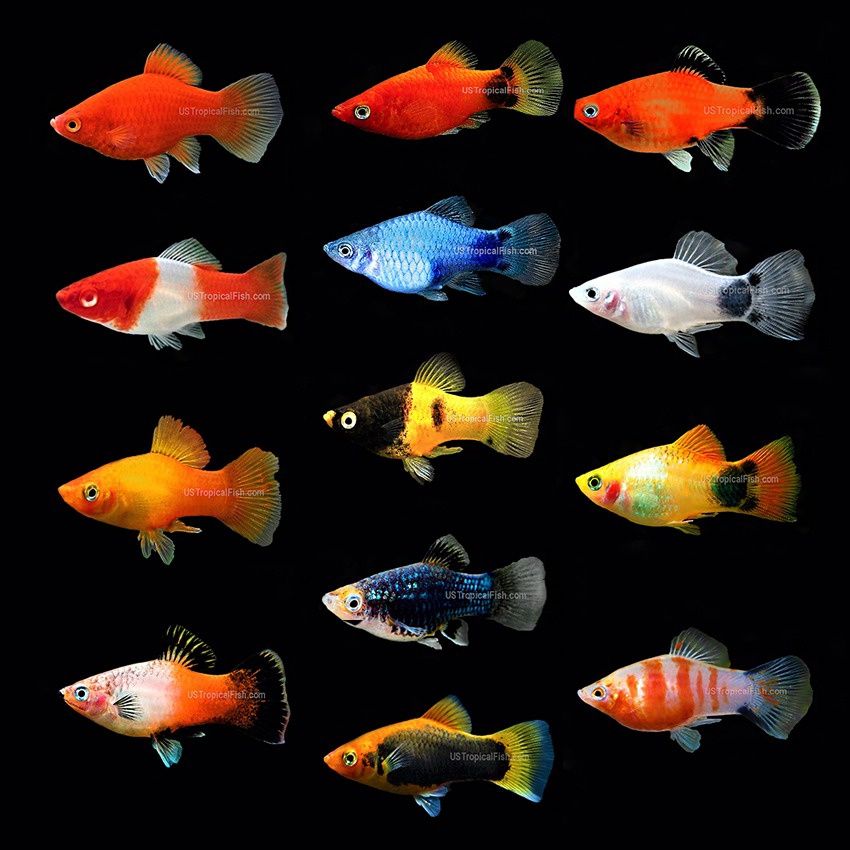Assorted Platy
Platies are vibrant, hardy, and easy-to-care-for freshwater fish, making them a popular choice for beginners and seasoned aquarium hobbyists alike. Here’s a comprehensive guide to keeping platies healthy and thriving in your aquarium:
Tank Setup
- Tank Size: Platies are small fish and do well in tanks as small as 10 gallons, but a 20-gallon tank is ideal if you plan to keep a group or have other tank mates.
- Water Conditions:
- pH: Platies prefer slightly alkaline to neutral water, with a pH of 7.0-8.2.
- Temperature: They thrive in temperatures between 70-80°F (21-27°C).
- Hardness: They prefer moderately hard water (GH 10-20 dGH).
- Filtration: Platies are not overly sensitive to water flow but appreciate clean water, so use a gentle filtration system to maintain good water quality.
- Aquascaping: They enjoy a well-planted tank with plenty of hiding spots. Live plants like Java moss, hornwort, and anacharis are great, but they can also live in tanks with artificial decorations.
Diet
- Omnivores: Platies are omnivores, meaning they eat both plant and animal matter. A balanced diet should include:
- High-quality flake food or pellets formulated for tropical fish.
- Live or frozen foods, like brine shrimp, daphnia, or bloodworms, for protein.
- Vegetables: Offer blanched vegetables like zucchini, spinach, or peas as part of their diet to provide essential nutrients.
- Feeding Frequency: Feed your platies 2-3 times a day. Give them only as much as they can consume in 2-3 minutes to avoid overfeeding and water contamination.
Tank Mates
Platies are peaceful and sociable, so they do well with a variety of other fish. They are often kept in schools and can live alongside:
- Compatible Tank Mates:
- Small, peaceful fish like neon tetras, guppies, corydoras catfish, and small gouramis.
- Other livebearers, such as swordtails and mollies, make good companions as they share similar care requirements.
- Avoid: Aggressive fish, such as large cichlids or predatory species, which may harm or eat platies.
Water Quality
Maintaining excellent water quality is essential for platies’ health:
- Regular Water Changes: Perform a 25-30% water change every week to keep the water clean and reduce the risk of diseases.
- Test the Water: Use an aquarium test kit to monitor ammonia, nitrites, nitrates, and pH levels regularly. Platies are sensitive to poor water conditions, so keeping the water parameters stable is important.
Breeding Platies
Platies are livebearers, which means they give birth to live fry rather than laying eggs.
- Mating: Platies are easy to breed, and males will often chase females. The female can store sperm for weeks, fertilizing multiple batches of eggs during that time.
- Fry Care: After a gestation period of about 4-6 weeks, the female will give birth to 10-40 fry. To prevent the fry from being eaten, consider having a breeding box or a separate tank for the newborns. Platy fry are small but fully formed and can swim immediately after birth.
- Fry Feeding: Newly born fry can be fed infusoria or microworms. As they grow, they can eat crushed flake food and small live or frozen foods.
Common Health Issues
Platies are generally hardy, but they can still experience a few health issues:
- Ich (White Spot Disease): Caused by a parasite, ich presents as small white dots on the fish’s body. It can be treated with aquarium salt or medications designed for parasite treatment.
- Fin Rot: Caused by poor water quality or injury, fin rot can cause the fins to appear ragged or decayed. It can be treated with antibiotics and improved water conditions.
- Swim Bladder Disease: If your platy has trouble swimming or seems bloated, it may have swim bladder disease. This can be caused by overfeeding or constipation. Feed them a diet of peas or fasting for a day to help resolve mild cases.
Behavior and Socialization
- Social Fish: Platies are very social and do best in groups. Keeping at least 3-5 platies together will make them feel more comfortable and reduce stress.
- Males and Females: If you have both males and females, be prepared for breeding. Males can sometimes chase females aggressively, so provide plenty of hiding spots.
- Peaceful Nature: They are not territorial and generally coexist peacefully with other non-aggressive species.
Lifespan
Platies typically live for about 3-5 years with proper care. Some individuals can live even longer under optimal conditions.
By providing a stable environment, a varied diet, and regular maintenance, platies can be a colorful and lively addition to your aquarium. They are easy to care for, making them great for beginners or those looking to add more life to their tank.

